So you’ve just noticed the pressure gauge on your pool filter is really low or the needle is showing no pressure. This is despite that fact that your pump appears to be working.
Low or no pressure in the pool filter means the pool water will not circulate properly. This is not a problem you can put off and if left unfixed, the filter will not filter the water properly, potentially leaving you with algae and cloudy pool water.
So how do you fix the problem? That’s what this post addresses. Let’s dive in.
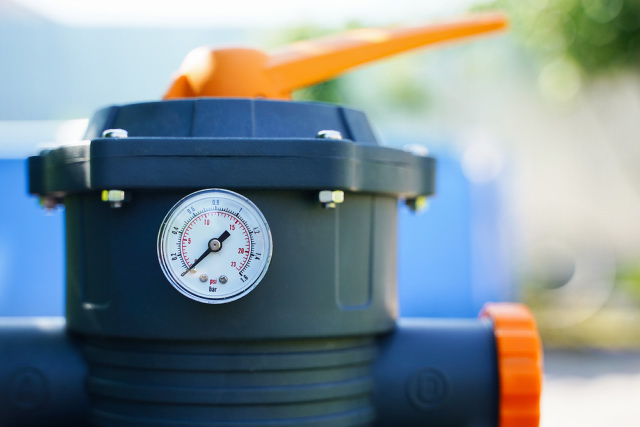
Article Contents
How Do You Know When The Pool Filter Pressure Is Low?
Here are signs that you’ll notice when your pool filter has a low or no water pressure.
1) Low Pressure Reading On The Filter Pressure Gauge
Any reading below 6 PSI indicates low water pressure in the pool filter. You should also know that a high PSI reading will cause low water pressure coming out of the return jets too. A general rule for pressure in the pool is a reading between 10 and 25 PSI.
2) Weak Returns Into The Pool Through The Jets
The water that flows through the pool return Jets is meant to be turbulent. If you notice weak returns into the pool, it indicates a low water flow.
3) Low Flow Warning
If you have a saltwater chlorine generator system, a low flow warning indicates that there isn’t enough water in circulation.
4) Air Bubbles In The Pool
Air bubbles in the pool or through the return jets can mean that the pool pump is being starved of water and is sucking in air. This isn’t the only cause of air bubbles in your pool though. If you are experiencing lots of air bubbles, check out our article:
Air Bubbles In Pool Or Pump | Causes and Dangers
5) Sluggish Pool Cleaners
If your pool cleaners are taking forever to work or moving slowly, it could be because of a low pressure problem in the pool. Most pool cleaners use the water pressure to operate and if the pressure is not high enough, they won’t work properly.
6) Low or No Water from Water Features and Fountains
If your pool is designed with a fountain or waterfall and the water is not coming out or it is very weak, it’s an indication of low water pressure.
Now you know how to spot low water pressure in the pool filter. But what causes it? Let’s find out.
Why is The Pool Filter Pressure Low?
There are several reasons that can cause a low or no pressure in the pool filter. Let’s check out the obvious reasons.
1) Clogged Skimmer or Strainer Basket
If the skimmer or pump strainer basket is clogged, the water flow rate will be slower than required. This will lead to low pressure in the pool filter.
These baskets get clogged by an accumulation of debris and scum and should be cleaned on a regular basis.
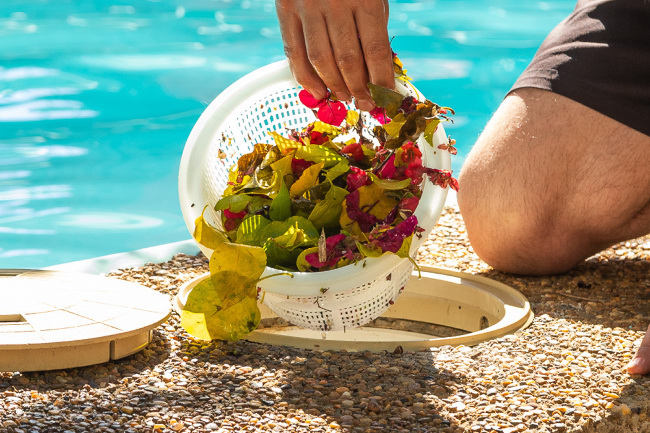
To fix this, start by turning off the pool pump. Then inspect the skimmer and pump baskets for dirt, leaves, debris, or dead rodents. After, take out the baskets, clean and return them. Damaged baskets should be replaced.
2) Pool Pump Is Off
This might sound silly but your pool pump might be off. The water won’t circulate at all without the pool pump running. The pool pump might also not be working due to a malfunction. In such instances, the pressure in the filter system will be zero.
To fix this, if you have a timer, manually switch it on to see if the pump is running. If the pump doesn’t come on, you’ll need to troubleshoot it. You can start by checking if the circuit breaker has tripped.
3) The Multiport Valve Is Set To Waste
The multiport valve is the big valve on top of your filter and controls the different functions.
If the multiport valve is set to “waste“, “backwash“, or “recirculate“, the filter pressure gauge will be zero. This is because, for these settings, the water flow bypasses the filter. Therefore, there is no pressure in the filter tank.
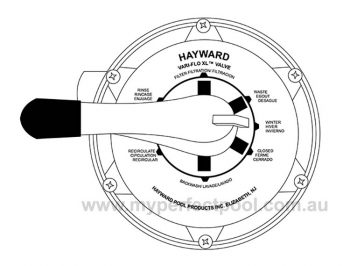
The pressure coming out of the return jets should be strong when set to “recirculate“, even with the pressure gauge reading zero. If it isn’t, you have a low pressure problem with the filter or pump.
To fix this, turn off the pool pump and set the multiport valve to “filter.” Then turn on the pool pump to circulate water to the filter system.
4) Valves Are Not In The Right Position
Sometimes, pool pipes have valves and unions that join them together. If these valves are inadvertently moved to the wrong positions, the whole filter housing may be by-passed. This will result in no or low pressure in the filter.
To fix this, inspect all valves and ensure they are in the right positions.
5) Pool Pump Has Lost Prime
This usually happens after turning off the pump. Sometimes, air pockets in the pool lines and pump get trapped after you turn it off. This can make the pool pump lose prime meaning that it won’t circulate water properly and you’ll have a low pressure reading in the filter system.
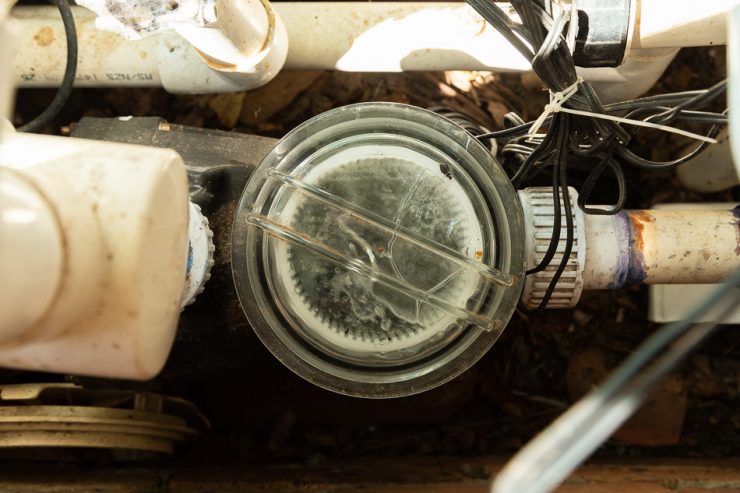
Look in the transparent pump lid. If the pump is primed, water should be filled all the way to the top. But if you see air bubbles through it or the water is half-way or one-third down, it means the pool pump has lost prime.
To fix this, you’ll need to prime the pool pump. It’s as simple as opening the pump lid and filling the pump with water. Check out how to do that here.
6) Water Level Is Too Low
Each time you go in and out of your pool, you splash some off the pool water out. Water also evaporates too, and you lose water when backwashing. If the pool water level gets too low, the pump will suck in air, leading to low water pressure in the filter system.
To fix this, check the skimmer opening in the pool. If the water is below the skimmer, that’s why you have a low pressure in the pool filter. You’ll need to top up the pool with water to the ideal level. The ideal water level should be a little bit above the mid-point of the skimmer opening.
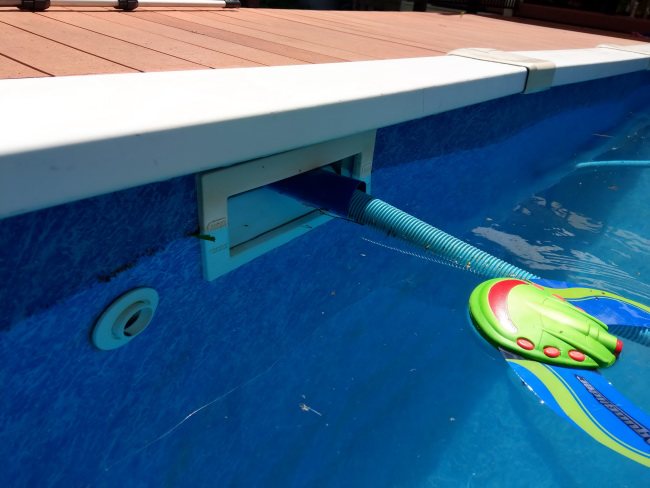
7) A Faulty Pressure Gauge
Sometimes, especially after the winter season, the needle in the pressure gauge might have gotten stuck or damaged and when this happens, it will display the wrong pressure reading or no pressure.
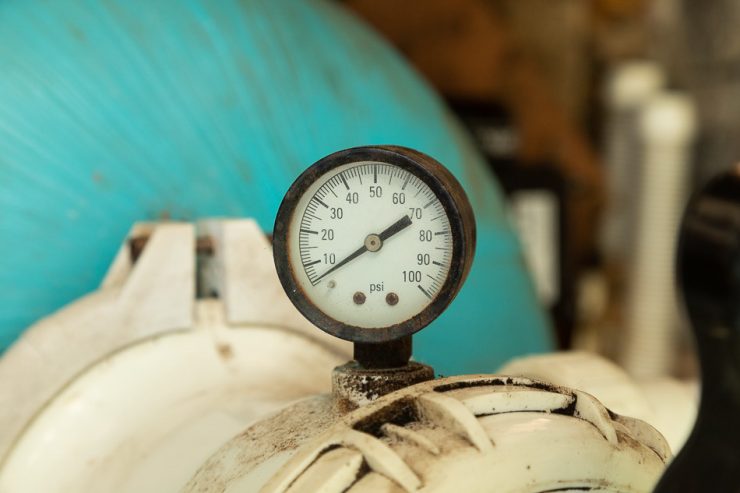
To fix this, sometimes, a simple tap on the pressure gauge will reset it. If that doesn’t work, you’ll need to replace the pressure gauge.
- Ensure you have an accurate pressure reading
- Cheap to buy & easy to replace
- The replacement range will fit most filters
8) Clogged Pressure Gauge Hose
If you unscrew the pressure gauge on your filter system, some of them have a hose that connects to the bottom of the pressure gauge. This hose takes water to the pressure gauge based on the flow rate in the pool.
If the hose is clogged or dirty, the pressure gauge will display a low water pressure.
To fix this, turn off the pool pump and unscrew the pressure gauge. Then clean the hose. After, screw the pressure gauge back in. Then turn on the pool pump to check the new reading.
9) Air Leak On The Suction Side Of The pool
The pool pump creates a vacuum that pulls water from the pool through the suction side of the pool. If there is an air leak on this side of the pool system, then the pool pump will suck in water and air.
This will cause the pump to lose prime or cavitate. If that happens you’ll have low pressure in the filter or no pressure.

Air leaks can be caused by loose or cracked pipe fittings, loose or damaged pool pump lid, unions, valves, O-rings, and the likes.
To fix this, first check leaks from the pump lid, inspect and tighten all pipe fittings and O-rings. Damaged parts should be replaced.
11) Clogged Pump Impeller
The impeller is the fan-like part of the pool pump. This is what pulls the water through the pump. If the impeller is clogged, the suction power of the pump decreases which means the pool pump can’t suck in enough water. This translates to a low water pressure in the filter system.
To fix this, turn off the pool pump at the breaker. Then open the pump lid and remove the pump basket. This grants you access to the impeller and you can clear out debris inside. After, return the pump basket and run the pool pump to check the water pressure.
12) Dirty Filter Element
Although this won’t cause low pressure (it will cause high pressure), it will mean that the water pressure coming out of the return jet’s is low.
If the filter is clogged, the water flow will be restricted.
To fix this, check and clean the filter elements. For cartridge filters, you’ll need to hose down the cartridge(s). You can also soak the cartridge(s) in filter cleaner to remove oils and grease.
For sand and DE filters, you’ll need to backwash the system. Check out this article to learn how to properly backwash your pool system.
We have checked out the obvious and most-likely reasons your pool filter has a low or no water pressure. Now, let’s check out other reasons that may not be as obvious.
13) Too Many Water Features Turned On
Features like waterfalls, waterslides and fountains need to be powered by a pump. And if you’re using your pool’s main filter pump to power these as well, your pump may be underpowered and not able to keep up.
You can test this by turning off the water features and then checking the pressure. If the pressure returns to normal, you will need to rethink the size of your pump and the plumbing configuration.
To fix, consider a separate booster pump to run the water features.
Check out this article: What is a Pool Booster Pump & Do I Need One? (Answered!)
Other Reasons For A Low or No Pressure In Pool Filter
1) Broken Pool Pipes Below Ground.
If you run an underground or in-ground pool, some of the pool pipes will be run underground. If any of these pipes are damaged or broken, it can cause water to leak below ground leading to a weak return flow or low pressure in the filter system.
Leaking pipes are usually fairly easy to find, just look for the wet back. However, unless you like digging up your yard, you might need a plumber’s help to fix this.
2) Pump is Too Small
In order to achieve the correct water pressure and flow rate, you must choose the correct size pump. If the pump is too small, it may not physically be able to move enough water.
Things that will affect the pump size are:
- size of filter
- size of pipes
- number of water features
- accessories such as pool heating
- size of the pool
3) Pool pump Housing Is Broken
A cracked pool pump housing will allow air to get in the pump and filter system. This will restrict water flow and lead to a low pressure reading on the pressure gauge.
Pro-Tips To Prevent Low Pressure In The Pool Filter
- Regularly clean the strainer and skimmer baskets.
- Ensure the water level is above the mid-point of the skimmer opening.
- Turn off the pool pump before switching functions on the multiport valve.
- Don’t clean the skimmer without turning off the pump.
- Keep tabs on the pressure gauge to stay ahead of any situation.
- Clean the pool filter regularly to prevent accumulation of dirt and debris.
Final Thoughts
Overall, a low or no water pressure in the filter system can be caused by many things. Go through this list and check one thing at a time until you find the cause.
So there you have it. If you liked this post, ensure to check out other helpful articles like it on this website for more pool tips.
Related Reading:
What is a Normal Pool Filter Pressure Range?
7 Problems With Pool Pressure Cleaners


I have an in ground pool that I’ve worked on for 1 1/2 month bought a new pump and backwashed a million times without success. After backwashing and adding DE powder it runs fine for a couple of hours then stops and starts sucking air. It is still green.